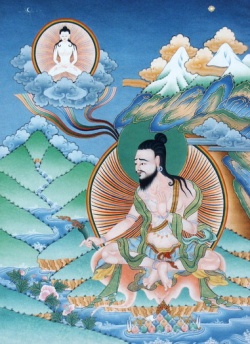Zhang Zhung Nyan Gyud
The Zhang-zhung snyan-rgyud is of particular interest to the history of the development of Dzogchen in Tibet because it is not a Terma, as are the other cycles of Bonpo Dzogchen texts such as the bsGrags-pa skor gsum and the Gab-pa dgu skor, but represents a snyan-rgyud, or "oral transmission." It is asserted in the Bon tradition that these teachings have been passed down in a continuous unbroken lineage of transmission of master to disciple since before the eighth century. Therefore, in this context snyan-rgyud corresponds to the Nyingmapa classification of a text as bka'-ma, or "a continuous tradition". The transcendental origin of Dzogchen according to the Bon tradition has been described in the previous chapter.
However, in strictly historical terms, it may be asserted that this Zhang-zhung Nyan-gyud derived from the oral precepts of a kind of Bonpo Mahasiddha known by the name of Gyerpung Nangzher Lodpo (Gyer-spungs snang-bzher lod-po), the disciple of another mysterious Mahasiddha, Tapihritsa, whom he encountered in a series of visionary experiences. This Gyerpungpa, who is almost certainly historical, was a contemporary of the great Buddhist king of Tibet, Trisong Detsan (742-797) and of the Buddhist master from Uddiyana, Guru Padmasambhava, who established the Tantric form of Buddhism known as Vajrayana in Tibet. Thus, Gyerpungpa and his master probably lived in the axial period of the eighth century to which the Nyingmapas equally look back to as the Golden Age for the establishing in Tibet of the teachings of their own tradition deriving from India, which also included Dzogchen. Gyerpungpa was not a Central Tibetan however, but a Zhang-zhung-pa, a native of the then independent kingdom of Zhang-zhung that included the nomad country of Northern Tibet where he lived.
Having received the permission of his master to write down the Dzogchen precepts in the Zhang-zhung language, it appears that either Gyerpungpa or his immediate successors did so and one of them, Ponchen Tsanpo (dPon-chen bTsan-po) in turn translated them into Tibetan in the ninth or tenth century. Moreover, Ponchen Tsanpo is portrayed in these accounts as having been bilingual, speaking both Tibetan and his native Zhang-zhung dialect. In the tradition it is clearly stated that it was Gyerpungpa who first wrote down the Dzogchen precepts and made them available to more than one disciple, whereas previously they had only been privately transmitted in an oral fashion from the master to a single disciple alone (gcig brgyud). Indeed, this had been the case from the time of Yongsu Dagpa, the disciple of Tonpa Shenrab and of Sangwa Dupa, until the advent of Tapihritsa in the historical period. From Gyerpungpa, an unbroken lineage of transmission can be traced down to the present day.
Some modern scholars have cast doubts on the historical existence of Gyerpungpa and his master, but the eminent Tibetologist David Snellgrove, who has studied the material, writes: "There is no serious reason for doubting the existence of the Bon sages who come within the historical period, and at the same time there is no doubt of the Indian Buddhist origin of their philosophical theories and meditation practices." Again, he writes of Tapihritsa: "He belongs to one of the several lines of meditating hermits who seem to have established themselves in Western Tibet from the seventh century on, and possibly even earlier."
Elsewhere, Snellgrove speculates about Tapihritsa possibly being of Indian origin because of the appearance of his name, which might have been originally tapiraja, probably meaning a prince or lesser king. However, Lopon Tenzin Namdak adamantly asserts that Tapihritsa was not an Indian traveler, but a native Zhang-zhung-pa and that his name derives from the Zhang-zhung language. In any event, Snellgrove sees no real reason to doubt the historical existence of a Zhang-zhung-pa Mahasiddha, such as Gyerpungpa, living in the caves about the western end of the Darok lake in Northern Tibet in the eighth century.
The historical existence of Tapihritsa is less certain than that of Gyerpungpa, but it appears that he was an actual Mahasiddha, living in Zhang-zhung or Northern Tibet, who flourished in the late seventh and early eighth centuries. In the recorded accounts, Tapihritsa's encounters with his disciple Gyerpungpa appear to be somewhat of the nature of visionary experiences, where he manifested to the latter in the guise of a miraculous youth. Certainly one is encountering here the archetype of the wise child. But this is no more fanciful than the encounters of Naropa with his own mysterious master, the Mahasiddha Tilopa. Modern scholars do not question the real historical existence of these two masters, Naropa and Tilopa. So we need not dismiss Tapihritsa out of hand as a later myth or literary fabrication, even though, according to the tradition, he reappeared to his disciple in a rather miraculous fashion after the former had attained enlightenment.
detail form John Myrdhin Reynolds - Vajranatha
